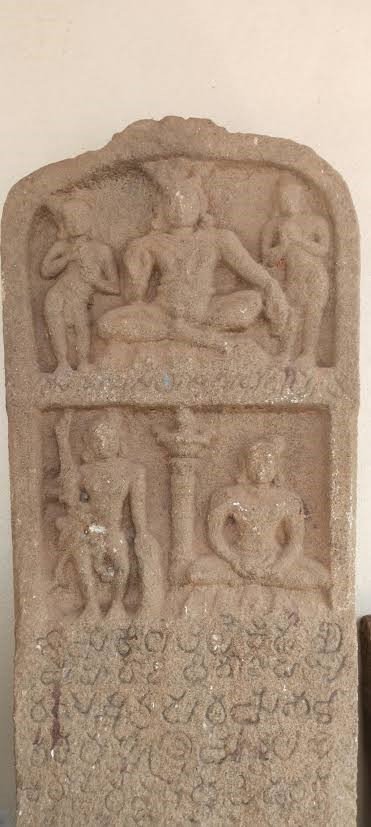
Someshwara inscription

21.10.2023
Someshwara inscription , Daily Current Affairs , RACE IAS : Best IAS Coaching in Lucknow
|
For prelims: Someshwara inscription,Important Rulers of Tuluva Dynasty For mains GS paper1: Kulashekara Alupendra,Alupa dynasty,Tuluva Dynasty,Tuluva Dynasty Economy |
Why in the news?
Recently, archaeologists discovered a rare inscription connected to the Alupa dynasty during a recent archaeological exploration at Someshwara near Mangaluru, Karnataka.
About the Someshwara inscription:
- This inscription is very significant in the study of Tuluva history and culture.
- It has two panels on the top, and in between the two panels, the first line is engraved.
- The rest of the inscription written below the panels is in Kannada script and the language of 12th century characters announcing the death of Alupendra I.
- The human figures shown in the inscription represent Kulashekara Alupendra himself.
- In the first figure, he is shown standing in Tribhanga (tri-bent posture). He holds a sword in his right hand while the left hand rests on a gurani (shield).
- To the left of this panel, divided by a pillar, the King is again shown in a sitting posture on a mound, resting both his palms on the centre of his legs in dhyana mudra.
Who was Kulashekara Alupendra?
- Kulashekara Alupendra I was a famous ruler of the Alupas of South Canara.
- He was responsible for the establishment of a new city called Kulashekara in Mangaluru.
- He also laid down strict rules and regulations for temple administration, which are still followed in all temples in this region.
- He was the first ruler to give royal patronage to Tulu language and culture, ruling from both the capitals, Mangaluru and Barkuru.
- Alupendra I ruled Tulunadu from 1156-1215 A.D., as known from his other records.
- Though the present inscription is undated, it is datable to 12th century on the basis of paleography.
The Alupa dynasty
- The Alupa dynasty (circa 2nd century C.E to 15th century C.E) was an ancient ruling dynasty of India.
- The kingdom they ruled was known as Alvakheda Arusasira and its territory spanned the coastal districts of the modern Indian state known as Karnataka.
- The Alupas in their prime were an independent dynasty, centuries after reigning due to the dominance of Kadambas from Banavasi, they became feudatory to them.
- Later they became the vassals of the Chalukyas, Rashtrakutas, Hoysalas with the change in political scenario of Southern India.
- Their influence over coastal Karnataka lasted for about 1200 years.
- There is evidence that the Alupas followed the law of matrilineal inheritance since the Alupa king Soyideva was succeeded by his nephew Kulasekhara Bankideva (son of Alupa princess Krishnayitayi and Hoysala Veera Ballala III).
- The last Alupa king to have ruled is Kulasekharadeva Alupendradeva whose inscription dated 1444 CE have been found in Mudabidri Jain Basadi.
The Tuluva Dynasty
- The Tuluva Dynasty was the third dynasty to rule the Vijayanagar Empire.
- They were chiefs from coastal Karnataka.
- The Tuluva Dynasty was one of the decision-making lines of the Vijayanagara Empire of Southern India.
- During this time, the Vijayanagar empire reached its pinnacle of splendour, with Krishna Deva Raya as its most celebrated king.
- From 1491 to 1570, they had five emperors.
- They ruled over much of South India, with Vijaynagar as their capital.
Important Rulers of Tuluva Dynasty
1)Vira Narasimha Raya (1505 - 1509 CE)
2)Krishna Deva Raya (1509 - 1529 CE)
3)Achyuta Deva Raya (1529 - 1542 CE)
4)Sada Siva Raya (1542 - 1570 CE)
Tuluva Dynasty Economy
- The Tuluva rulers ruled Vijayanagara from 1485 to 1570. They focused on improving the kingdom's economy.
- Agriculture was the mainstay of the Vijayanagara economy. Rice was the main crop. Other crops grown were ragi, wheat, pulses and oilseeds. Cash crops like cotton, tobacco and sugarcane were also cultivated.
- Irrigation support helped agriculture. The kingdom had channels, tanks and wells for irrigation. Major rivers also supplied water. Kings built new irrigation works to expand cultivation.
- Sericulture of silk production was important. Silkworm rearing and weaving of silk were done in households. Vijayanagara silk was renowned for its texture and designs.
- Cottage industries involved in steel and wood works, handicrafts, textiles and dyeing also thrived.
Source:The Hindu